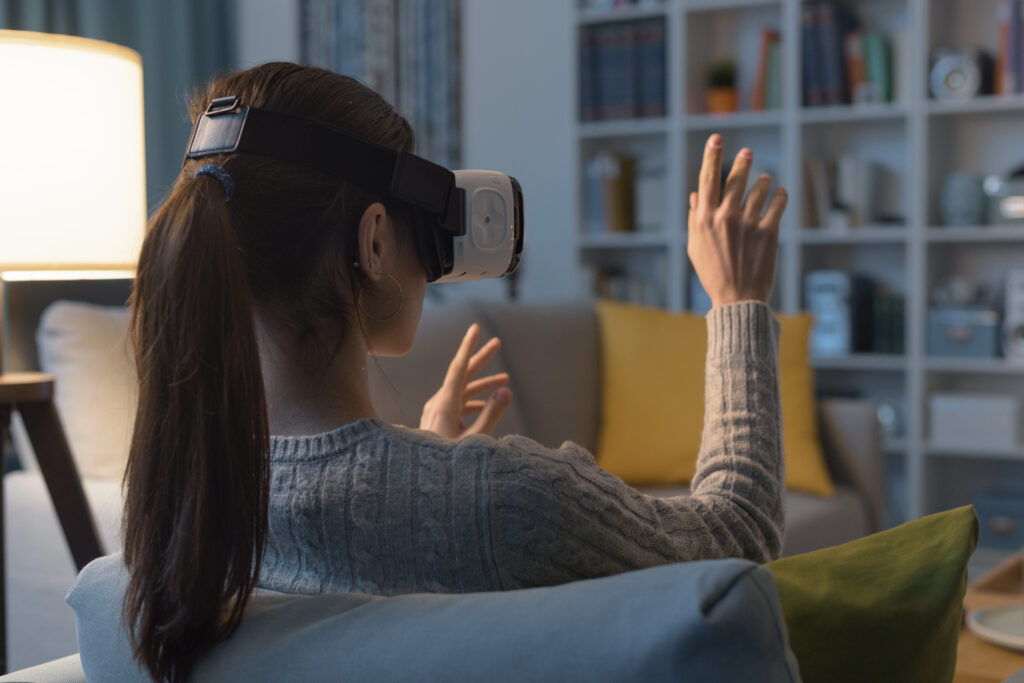As a film director with ECG Productions, I’ve closely observed the remarkable VR Cinema Evolution, a journey that compels us to redefine storytelling. There’s a tangible buzz around VR Filmmaking, or Virtual Reality in Filmmaking, a beacon of Cutting-Edge Filmmaking Technology that’s dismantling traditional barriers and enabling a fusion of narrative depth and interactive engagement. My experiences through ECG Productions, based in Atlanta, confirm that VR isn’t merely a fleeting trend; it’s a seismic shift in how we craft and consume cinema, inviting audiences not just to observe but to partake in the unfolding stories around them.
In this immersive canvas, the audience is no longer a passive bystander; they’re granted a front-row seat in the midst of action—embarking on journeys hitherto confined to the imagination. Embracing this innovation, I’ve witnessed the birth of a narrative revolution, stretching the confines of creativity to transport viewers into the very heart of the film. Let’s delve into the ways VR is sculpting the future of cinema, one immersive frame at a time.
Key Takeaways
- VR is revolutionizing the way stories are told, creating experiential narratives that engage audiences like never before.
- Magical realism meets technological prowess, transforming passive viewing into an active journey within cinematic worlds.
- ECG Productions is at the forefront, harnessing the power of VR to redefine the parameters of storytelling in film.
- Virtual Reality in Filmmaking grants directors new tools to direct and choreograph experiences in 360-degree environments.
- With VR, cinema is evolving beyond its century-old format, entering an era of boundless storytelling possibilities.
The Rise of VR Technology in Modern Filmmaking
Reflecting on the Evolution of VR Technology within the realm of cinema, I’ve observed a monumental transition from its inception to its current status in the sphere of VR Mainstream Filmmaking. The ascent of Virtual Reality from a mere token of science fiction to a bona fide cinematic tool has been nothing short of breathtaking, marking the VR Journey in Cinema as a pivotal chapter in the annals of film.
From Novelty to Mainstream: The VR Journey
Not too long ago, VR’s presence in film was a showcase of potential at tech expos and select enthusiast meetings. Yet, My journey through various film festivals has revealed a consistent theme: Virtual Reality has transitioned from a peripheral gimmick to a central experience, praised and sought after by creatives and consumers alike. This signifies a significant milestone in the VR Journey in Cinema, emphasizing the technology’s establishment in the eyes of industry professionals and audiences.
“Virtual Reality in filmmaking is not just an accessory; it’s the portal to a new era of cinematic excellence.”
Every year, the burgeoning interest in Virtual Reality’s application in film is palpable, with VR experiences becoming a staple attraction.
Innovations Driving the Adoption of VR in Film
Key innovations have played a crucial role in fostering the Adoption of VR in Movies. It’s not merely the technological allure of VR but the tangible improvements in accessibility and functionality that have empowered filmmakers. I take pride in recognizing how ECG Productions has embraced these changes to pioneer novel storytelling vistas.
- Declining costs of VR equipment make it a viable option for a broad range of budgets.
- Enhanced graphical fidelity offers audiences an unprecedented level of realism.
- The advent of more intuitive VR cameras simplifies the content creation process.
These VR Technological Advances have eliminated former barriers, invigorating filmmakers with the freedom to experiment and explore narrative dimensions heretofore thought inconceivable. The tangible, immersive possibilities now within our grasp signify a revolutionary leap for the art form.
The affordability and sophistication of today’s VR technology enable storytellers like myself to blur the lines between fantasy and reality, transporting film lovers into the heart of the action. It’s a testament to the vibrant and inexorable progression of Virtual Reality, as it firmly cements its place in the tapestry of modern filmmaking.
How VR is Changing the Pre-Production Process
When it comes to filmmaking, the pre-production stage is where the seeds of creativity take root and the planning for the cinematic piece begins. My exploration into the use of VR during this phase has revolutionized how we approach filmmaking at its nascent stage. Specifically, the advent of VR in Pre-Production has opened up a world of possibilities that were hitherto unimaginable.
“Utilizing VR for storyboarding and location scouting is not just an enhancement; it’s a complete reimagination of the planning phase.”
Traditional storyboarding, a critical step in visualizing scenes for directors and clients, has been transformed by VR Storyboarding. Adaptation to this innovative approach requires a paradigm shift in visualization, where a flat storyboard becomes an immersive experience. Let me share with you the ways in which VR is sculpting the pre-production landscape:
- Envisioning the 360-Degree Space: Crafting a VR storyboard demands thinking beyond the frame. I imagine the entirety of the environment around the viewer, bringing a level of detail and depth to planning that traditional methods cannot match.
- Interactivity Consideration: In VR, the audience can interact with the environment. This interactivity shapes how I plot out each scene, considering the numerous paths a viewer might take.
But the transformations don’t stop there. One of the most impressive capabilities VR brings to pre-production is virtual location scouting. The essence of finding the perfect setting is crucial to storytelling, and VR facilitates this by projecting us into prospective locations. The efficiency and cost-effectiveness of this method have significantly impacted the VR Filmmaking Workflow.
- Immersive Experience: Clients and team members can now step into numerous potential filming locations from the comfort of the studio, making informed decisions about setting and aesthetics before a single travel arrangement is made.
- Interactive Exploration: The interactive exploration of settings ensures that every angle and element aligns perfectly with the desired cinematic look and feel, eliminating guesswork and surprises when arriving on location.
The pre-production phase, bolstered by VR technology, is seeing a newfound dynamism, providing filmmakers like me with tools to efficiently and creatively lay the groundwork for stories that are about to be told. It’s a multifaceted challenge, yes, but more so an opportunity for unparalleled creativity and precision in the filmmaking process.
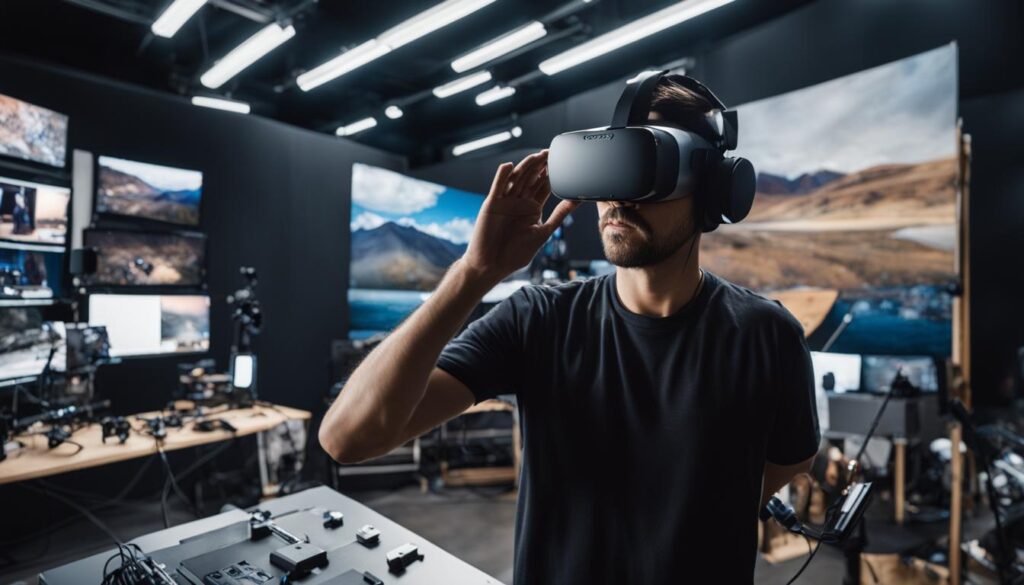
As we continue to navigate through the uncharted territories of VR in cinema, one thing is clear – these advancements are not just redefining workflows; they are redefining the very fabric of cinematic storytelling.
The Art of Storytelling Through Virtual Reality
The realm of Virtual Reality (VR) has opened a new chapter in the annals of storytelling, one that’s replete with boundless opportunities for immersive experiences. Scriptwriting in VR isn’t merely about dialogue and scene descriptions—it’s about envisioning and architecting worlds that users can live within. The narrative structure in VR is akin to a multidimensional tapestry, woven with the threads of interactivity and spatial awareness.
Scriptwriting for VR: Crafting Immersive Narratives
In the world of Immersive VR Storytelling, my scriptwriting transcends the traditional linear narrative, allowing for a multi-branching storyscape that accounts for audience autonomy. It’s a thrilling challenge—orchestrating storylines where the viewer’s decisions influence the unfolding plot. Consider for a moment the intrigue and allure that comes from not just watching a mystery unravel but being an active participant in the discovery.
- Creating narratives that accommodate the viewers’ exploration and interaction.
- Designing scripts with potential user paths in mind, ensuring each is as compelling and detailed as the central plot.
- Embedding narrative cues that organically lead to key story points.
Through the nuanced art of scriptwriting in VR, I forge a connection between story and audience, one that is both visceral and intimate, with a depth facilitated only by this medium.
Directing Viewer Attention in a 360-Degree World
The directorial techniques in the wraparound world of VR demand a unique and delicate balance. As a director in the ecosystem of 360-Degree VR Filmmaking, I have learned to master the art of guiding without commandeering, allowing the viewer’s attention to flow naturally across the spherical canvas before them. What follows are a few techniques that have become cornerstones of my directorial approach:
- Utilizing soundscapes with audio cues that steer attention subtly, suggesting rather than commanding viewers to look in a particular direction.
- Implementing visual elements of contrast or motion to draw the gaze, mirroring the way our eyes respond to the environment in the real world.
- Choreographing character and object movements within the scene, creating a dance that guides without restriction, allowing the user to feel in control.
The task of directing viewer attention in VR is an intricate interplay of technology and psychology, one that I embrace with the enthusiasm of a pioneer in new territory.
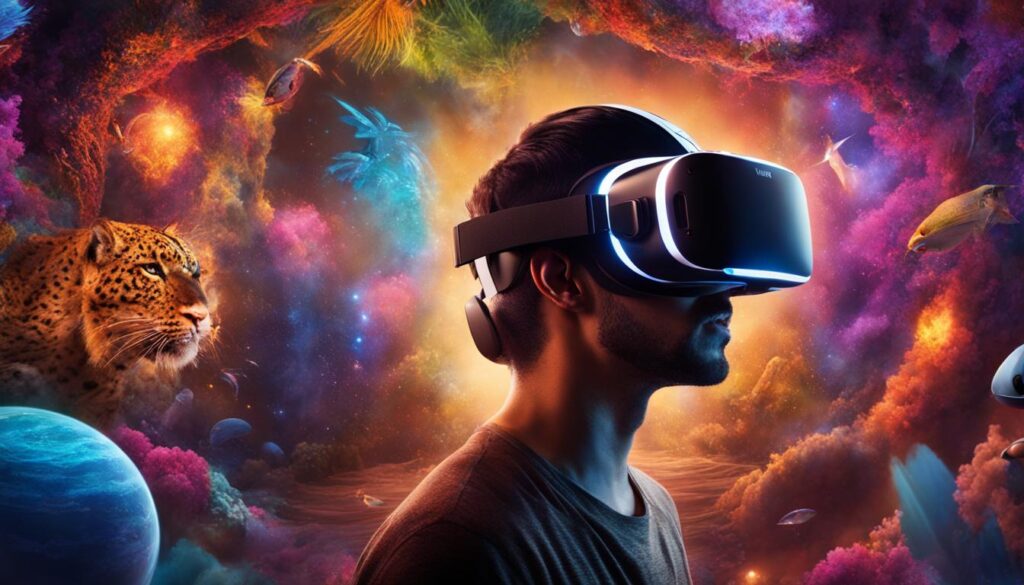
By integrating these directorial elements into my VR narrative structure, I ensure that my viewers are not just spectators but explorers of a living, breathing world that they are an integral part of. Through these methods, the viewership for my films becomes an active experience—a journey that each person shapes with their individual gaze and curiosity.
“In Virtual Reality, the audience is not just watching a story—they are a part of it, navigating through its layers and contributing to its finale.”
VR Filmmaking Tools: Cameras and Equipment
There’s a palpable excitement every time I lay my hands on the latest VR cameras and Virtual Reality Filmmaking Gear. As an enthusiast and advocate for innovation in cinema, I’ve had the fortune of working with cutting-edge VR Production Equipment that not only challenges the traditional ways of storytelling but also enhances it. This constant technological evolution empowers even indie filmmakers to create memorable VR experiences.
My journey in the VR landscape has acquainted me with a spectrum of tools, from high-end rigs capable of capturing crisp, film-quality footage, to more accessible solutions that democratize the VR filmmaking process. Today’s market is saturated with options, each bringing something unique to the table.
Real-time stitching rigs are a game-changer in my VR filmmaking arsenal, offering dynamic possibilities that were once the stuff of dreams.
In an industry that thrives on innovation, the VR tools we use today are constantly being refined. Allow me to introduce you to some of the indispensable pieces of equipment that are shaping the future of virtual reality in cinema:
- An array of VR cameras that cater to various production scales, ensuring that both indie creators and professional studios can find something within their realm.
- Advanced stitching software that seamlessly blends multiple camera feeds, providing an uninterrupted 360-degree view that is essential for immersive storytelling.
- Real-time monitoring equipment, crucial for maintaining the quality and consistency of VR footage as it’s being captured.
One cannot overstress the sheer versatility of today’s VR filmmaking gear. Whether it’s for creating spherical panoramas, capturing the minutest details in a virtual environment, or enabling live-action VR, the tools we have at our disposal are truly transformative.
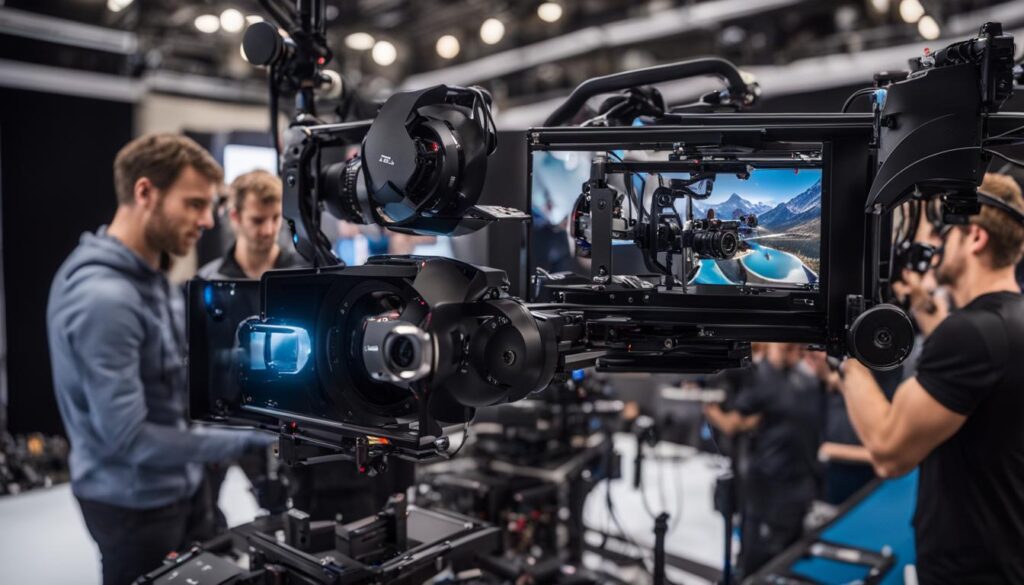
I’ve witnessed these tools not only enhance the visual splendor of VR productions but also streamline the filmmaking process. When you equip talented minds with such powerful devices, the outcome is nothing short of cinematic magic.
From cinematic VR cameras like the Nokia OZO and GoPro Fusion to more budget-friendly options like the Samsung Gear 360, there’s equipment for every aspiration and ambition. Even the supporting tech like gyroscopic stabilizers and advanced audio rigs contribute significantly to raising the bar in VR film production quality.
To all hopeful filmmakers contemplating the leap into VR – the perfect blend of equipment empowering a vast array of creative expressions awaits you. There’s a piece of VR production equipment tailored for every vision, and I urge you to join me in this innovative ride that’s redefining the essence of filmmaking.
Shooting Techniques Unique to Virtual Reality
Embarking on the exhilarating path of VR filmmaking, I’ve discovered that the auditory landscape is just as crucial as the visual. Spatial Audio in VR is pivotal—it’s the anchor that places the viewer firmly within the virtual environment. I often find myself awe-struck by the potent atmosphere created when immersive audio techniques harmonize with the visual spectacle.
Understanding Spatial Audio in VR
Filming in VR isn’t just an exercise in visual craftsmanship; it also demands mastery over the VR Sound Capture. To execute this, I utilize ambisonic microphones designed to record sound from every direction. These high-fidelity devices capture a full 360-degree soundscape, effectively mirroring the immersive experience sought by VR enthusiasts.
- 7th directional microphone configuration creates a multi-layered acoustic environment, essential for genuine spatial orientation.
- Resonant Frequencies and Acoustic Signatures: I take into account the echo and resonance of each virtual space to curate a more lifelike auditory experience.
- Dynamic Range and Clarity: Ensuring the sound quality matches the visual fidelity is vital, as it contributes to the overall believability of the VR experience.
Challenges and Solutions for VR Cinematography
In the realm of VR Cinematography, I confront unique challenges that push the boundaries of innovation. One such hurdle is the correct placement of cameras to preserve the illusion of solitude in the vastness of the VR landscape—ensuring that neither crew nor equipment shatters the virtual mirage.
- Remote Monitoring: By utilizing advanced remote systems, I can helm the camera from a distance, allowing for unblemished 360-degree scenes.
- Employing cleverly designed ‘invisible’ camera stands that can be edited out in post-production ensures seamless integration of the VR world.
- Allowing for Viewer Autonomy: I choreograph each scene while acknowledging the viewer’s freedom, maintaining a balance between narrative guidance and exploratory liberty.
Conquering these VR Filmmaking Challenges is more than technical triumph; it’s a testament to the creative spirit that thrives within the medium of Virtual Reality.
Every step of creating these immersive worlds is filled with the joy of discovery and the thrill of innovation. By combining immersive audio techniques with the finesse of VR shooting techniques, the result is a robust sensory encounter that is both enveloping and unforgettable. Embracing these technologies promises a future of storytelling that’s incredibly tactile, interactive, and enveloping—a narrative that you can step into and live within.
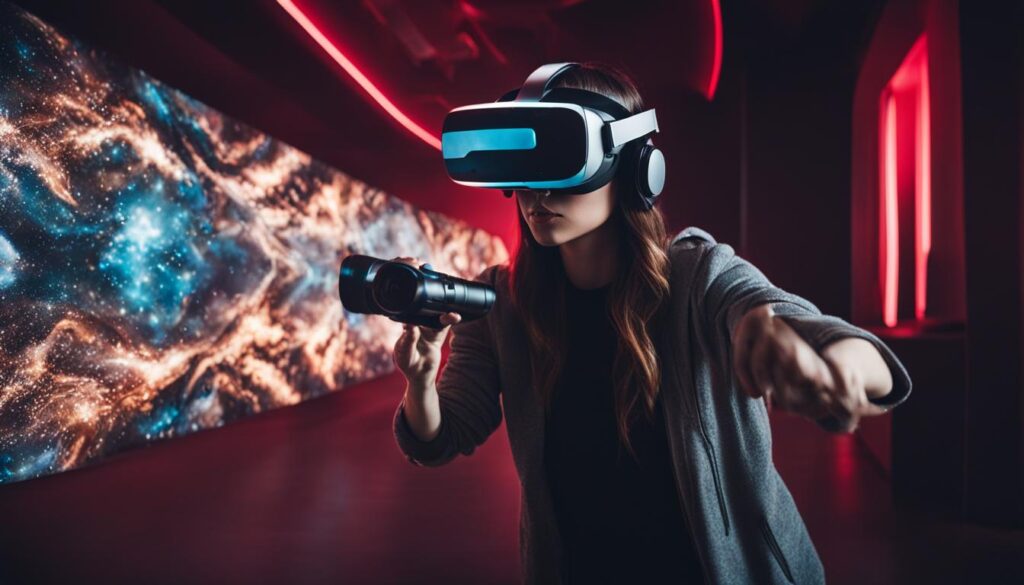
Post-Production in VR: Stitching it All Together
The panoramic world of virtual reality filmmaking culminates in an intricate dance known as VR post-production, a stage where the magical becomes real. Imagine stitching together a quilt made of visions; that is precisely what VR video stitching entails—meticulously merging separate camera feeds into one spherical masterpiece.
Editing for VR: A New Dimension of Challenges
While traditional video editing navigates through timelines and frames, VR editing wades through an ocean of spatial continuity. The task is Herculean—considering not just the narrative flow, but every conceivable angle within a 360-degree landscape. In my journey of editing, I often face the complex VR editing challenges that require both creativity and precision.
VR filmmaking is like orchestrating an immersive symphony, where each edit can transport the viewer to different worlds at the junction of reality and fantasy.
With new visions come new tools. The array of advanced VR-specific software at the disposal of post-production teams today is revolutionizing the way we sculpt VR experiences. These technologies handle the high-resolution footage with the finesse needed to maintain immersion without a seam in sight.
- Innovative stitching software that bridges the gaps between camera feeds, creating a flawless 360-degree environment.
- Robust editing suites that allow for real-time feedback and adjustments, keeping the editors a step ahead in VR cinematography.
Stitching and editing in VR aren’t just about aligning images; it’s about preserving the story’s essence in every pixel, ensuring that each scenic element contributes to a narrative that beckons viewers to step inside and live the tale.
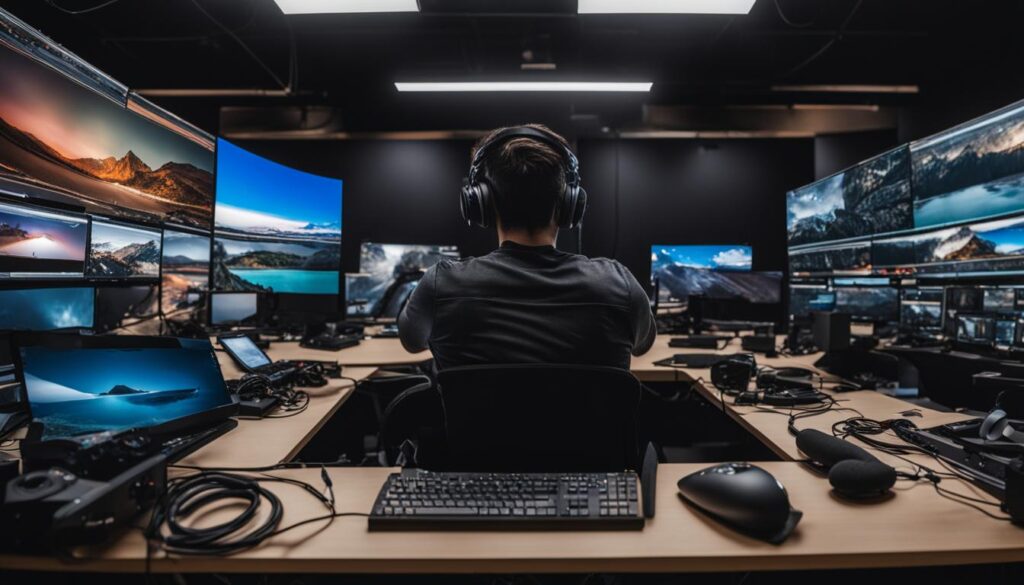
Watching countless hours of footage transform into an enclosed universe offers a unique satisfaction. The role of a VR post-production artist morphs into that of an alchemist, turning raw visual elements into a potion for escapism. Through this meticulous craft, we are not just building virtual worlds, we are defining future realities.
The Role of VR in Film Distribution and Exhibition
As an innovator and enthusiast entrenched in the world of storytelling, I have seen how Virtual Reality (VR) is reshaping the contours of film distribution and exhibition. With VR technology’s burgeoning presence in the cinema landscape, there’s an upbeat whirlwind surrounding VR Film Distribution, VR Exhibition Methods, and VR Content Dissemination. The customary cinematic experience is witnessing a metamorphosis, pivoting from the familiar buzz of movie theater lobbies to the intimate ambience of personal spaces equipped for VR viewing.
Traditional movie theaters, with their collective experience and buttery popcorn charm, lack the requisite infrastructure for VR. However, cinema is breaking free from its confines and setting foot into novel spheres. VR-specific venues are emerging as luminary havens that cater specifically to the immersive nature of VR films. These spaces are designed to engage and enthrall, offering a communal yet individualized experience that deepens the connection between the viewer and the narrative.
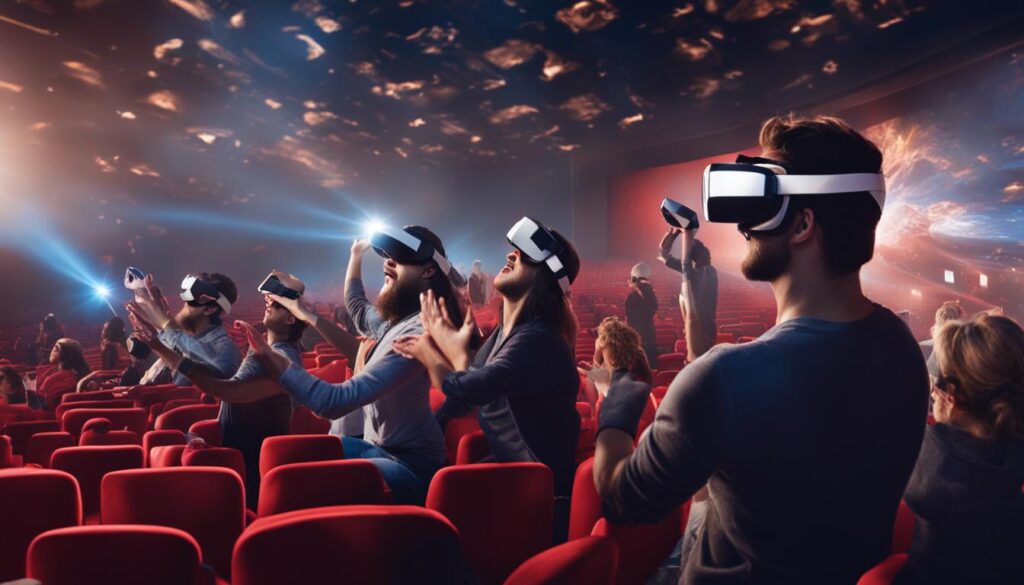
Furthermore, the festival circuit is embracing VR with open arms, with sections dedicated to virtual reality experiences. Festivals like Sundance and Tribeca are spotlighting VR narratives, acknowledging the medium as a significant craft in modern storytelling. These are vibrant playgrounds where VR Exhibition Methods are explored and celebrated, showcasing content that’s as divergent and powerful as their creators.
Events dedicated to VR content offer not only a window but an entire doorway to the future of film distribution and exhibition.
Nevertheless, it is the ascendancy of online platforms that are becoming more agile, inflammable spaces for VR content. Tech behemoths and streaming services are enhancing their infrastructure to accommodate the distribution of VR films, heralding a convenience that beckons viewers to immerse themselves in stories from wherever they may choose to be.
Moreover, the concept of ‘going to the movies’ is getting a refresh as home-based VR technologies become more affordable and widespread. The torchbearers of this initiative—gadgets like Oculus Quest and HTC Vive—are providing the general population with the means to experience cinema like never before: personally engaging, vividly tactile, and profoundly enveloping.
In essence, the role of VR in film distribution and exhibition is creating an inclusive chapter where audiences can not only cross the threshold into the narrative world but also decide how and where they choose to engage with it. It’s an exhilarating time for film enthusiasts and creators alike, as we stand at the cusp of a new paradigm in cinema—a paradigm where accessibility and immersion are the lodestars, guiding us towards a future rich with cinematic innovation.
Case Studies: Successful VR Film Projects
In my exploration of how VR has reshaped cinematic storytelling, I’ve had the pleasure to discover VR Film Success Stories that have not only demonstrated the dazzling potential of the medium but have also left an indelible mark on audiences and critics alike. These notable VR projects are case studies in innovation, each proving that VR can deliver emotionally rich and immersive experiences that rival traditional filmmaking. Let’s examine a few projects that epitomize the success VR filmmaking can achieve.
“Each of these VR films is more than just a technological marvel; they are portals to vastly different worlds, offering unique, enveloping narratives that engage the audience at a core level.”
The Importance of Freedom of Touch, a VR documentary, transported viewers into the lived experiences of individuals with disabilities, making it one of the keenly impactful VR Film Case Studies of recent times. This project challenged my preconceived notions on narrative structure by allowing the audience to “touch” and interact with the surroundings, forging a deeply personal connection to the stories.
- Used VR interactivity to break down barriers and foster empathy.
- Provided a vivid, first-person perspective on the challenges others face daily.
Another project that captured hearts was Clouds Over Sidra, a poignant VR experience that follows a day in the life of a 12-year-old girl in a Syrian refugee camp. By enabling viewers to step directly into her world, this project showcased the tremendous capacity of VR to drive home narratives with social significance.
- Immersive storytelling elevated the emotional weight of the narrative.
- Efficiently utilized VR’s unique capabilities to increase global awareness and compassion.
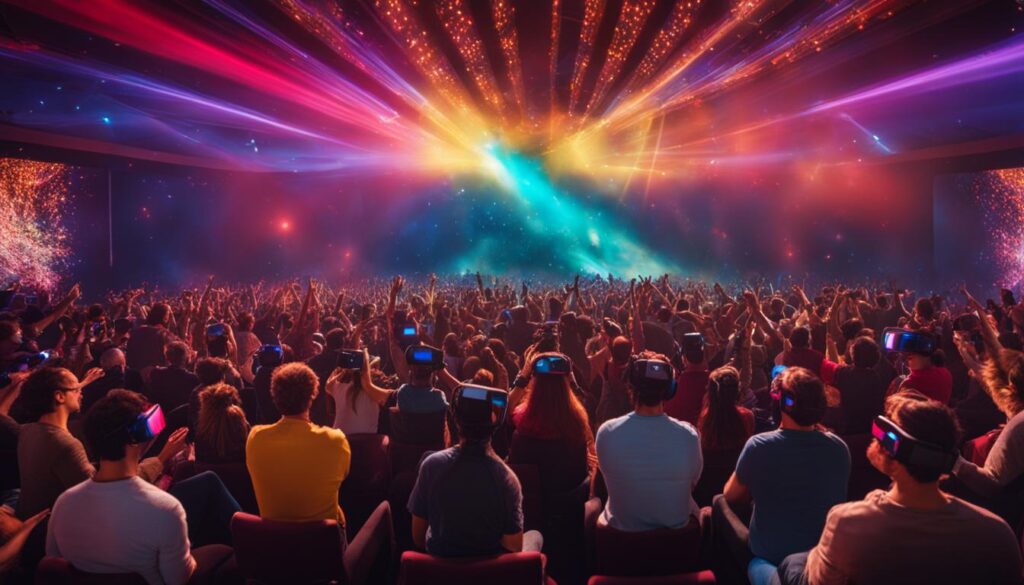
In the realm of narrative fiction, Henry, a VR short film by Oculus Story Studio, illustrated the charm and warmth VR can convey in storytelling. This endearing tale about a lonely hedgehog who longs for friends fully utilized VR’s potential to create a connection between character and viewer that feels tangible and heartfelt.
- Masterful use of emotional storytelling to connect the audience with the titular character.
- Set a new benchmark for emotional depth in VR narrative shorts.
These projects, among many others, stand as robust examples of the versatility and force of storytelling that VR brings to the table. As incredible as these tales are, they’re just the tip of the iceberg. I anticipate the continued growth and success of VR filmmaking, fortified by unyielding creative spirits and an enthusiastic audience eager to experience the next wave of VR Film Success Stories.
VR Filmmaking and its Industry Impact
As we delve into how virtual reality is revolutionizing the film industry, it’s clear that VR Opportunities for Filmmakers are evolving at an unprecedented pace, offering a renaissance of creative expression and storytelling prowess. The shift towards VR Creative Freedom heralds a new era where the visual narrative is limitless, and the audience is immersed directly in the unfolding drama, redefining their role from mere spectators to active participants within their own cinematic adventure.
How VR Creates New Opportunities for Filmmakers
In the domain of VR, the canvas of creativity is vast, unbounded by the traditional constraints that have long dictated the parameters of filmmaking. My career has witnessed a remarkable transition as VR has granted me the license to reimagine storytelling with a level of participation and depth that was previously inconceivable. It is here, within virtual realms, that narratives breathe, evolve, and respond to the viewer’s touch—a revolution that thoroughly embodies the notions of VR Industry Impact and the number 11, symbolizing innovation and pushing boundaries.
- Pioneering platforms have emerged, offering resources and support that encourage exploration in VR storytelling.
- VR has demolished the fourth wall, inviting filmmakers to construct worlds that audiences can step into and live within.
- The flexibility of VR enables a more diverse storytelling palette, capable of addressing niche subjects or perspectives that might not find a home in traditional cinema.
The advent of VR has stimulated an unparalleled creative metamorphosis, enabling film auteurs to wield technology as an extension of their artistic voice. This is not merely an evolution; it is a complete overhaul of the narrative form, empowering creators to foster immersive worlds with layers of complexity and interactivity worthy of their visions.
Virtual Reality as a Game-Changer for Audience Engagement
Virtual reality’s most profound impact lies in the profound potential for VR Audience Engagement. VR establishes an intimate connection, a shared existence between the audience and the narrative that traditional mediums cannot replicate. In my ventures through VR storytelling, I have seen first-hand how this immersive experience can stir emotions and foster an unparalleled depth of empathy within viewers.
With VR, every scene invites the audience to explore and connect—each moment is a living tableau that they can investigate and inhabit, not just observe from a distance.
In this dynamic game of engagement, VR is the maestro, orchestrating a symphony where the audience’s senses are the instruments, and their presence within the story is the melody. This harmonious blend of participation and perception makes VR a definitive VR Game-Changer in the cinematic landscape.
- VR transports viewers to the heart of the narrative, creating poignant moments that resonate with authenticity.
- Interactive features enable viewers to influence the story trajectory, instilling a sense of agency that deeply commits them to the virtual journey.
- The experiential nature of VR fosters a shared emotional experience that magnifies the impact of the film’s message.
The medium of virtual reality has catalyzed an evolution in audience engagement, crafting ephemeral moments that linger far beyond the screen. It offers a foray into realms where narrative is not a fixed path, but a living organism that grows and reacts to the gaze and decisions of its beholder—a true testament to the transformative power of VR in film.
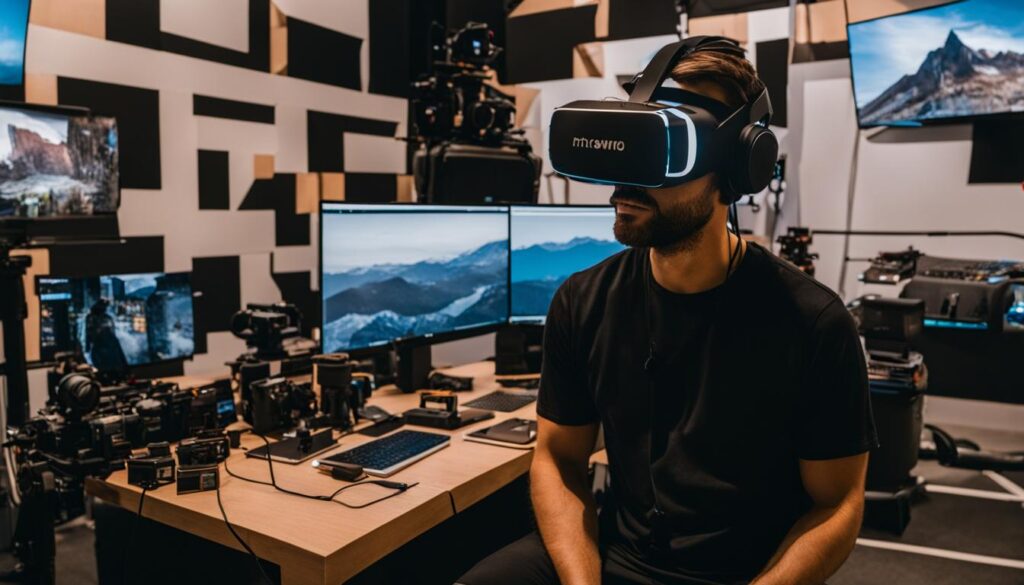
The influence of VR is not a fleeting trend; it is a towering wave that reshapes the filmmaking landscape with every narrative and experience it births. And it is within these digital vistas that the future of cinematic storytelling takes flight—imbued with the dreams and ambitions of filmmakers empowered by the boundless opportunities and creative freedom that only virtual reality can offer.
Future Trends: What’s Next for VR in Movie Making?
As I cast my gaze forward, I can’t help but get invigorated by the potential that VR future trends hold for the art of filmmaking. In my estimation, we are on the cusp of a new frontier, where innovations in VR filmmaking will continue to rewrite the script on what’s possible in cinema. I foresee a future dense with interactive narratives, where viewers, with deepened agency, become an integral part of the storytelling process.
“The horizon of VR in movie making stretches far and wide, dotted with advancements that promise to enrich every thread of cinematic fabric.”
The next phase in the VR cinema forecast points to a democratization of this technology, making it more accessible and allowing for a broader range of voices and perspectives to be expressed through film. The evolution we’ve already seen is just the beginning, akin to the early days of CGI, as VR gears up to be as ubiquitous and transformational for the movie-making industry.
- Interactivity and Engagement: Audiences can look forward to a more hands-on experience, influencing narratives in real-time and making choices that steer the story.
- Visceral Realism: Higher fidelity visuals are on the rise, advancing to a point where distinguishing between VR and reality becomes a delightful challenge.
- Universal Access: With VR tech becoming more affordable and accessible, we will see an increase in indie and experimental works that push the boundaries of storytelling.
Witnessing these trends unfold, it’s apparent to me that at the very core of these changes is the drive to bring the experience of cinema into the realm of the personal, and transform every viewing into an event of profound engagement. This is not just a fanciful prediction; every day, we see these trends gaining momentum.
“Virtual reality stands poised to offer filmmakers a canvas so limitless that, one day, it may redefine the very essence of what it means to make a movie.”
Whether it’s refined motion capture techniques that bring actors’ performances to shimmering life within the VR sphere or AI-driven story engines that adapt narratives to viewers’ responses in real-time, I am thrilled at the prospect of being part of this inventive wave. And as ever, my commitment remains to not just witness but to play an active role in crafting the VR cinema forecast that lies ahead.
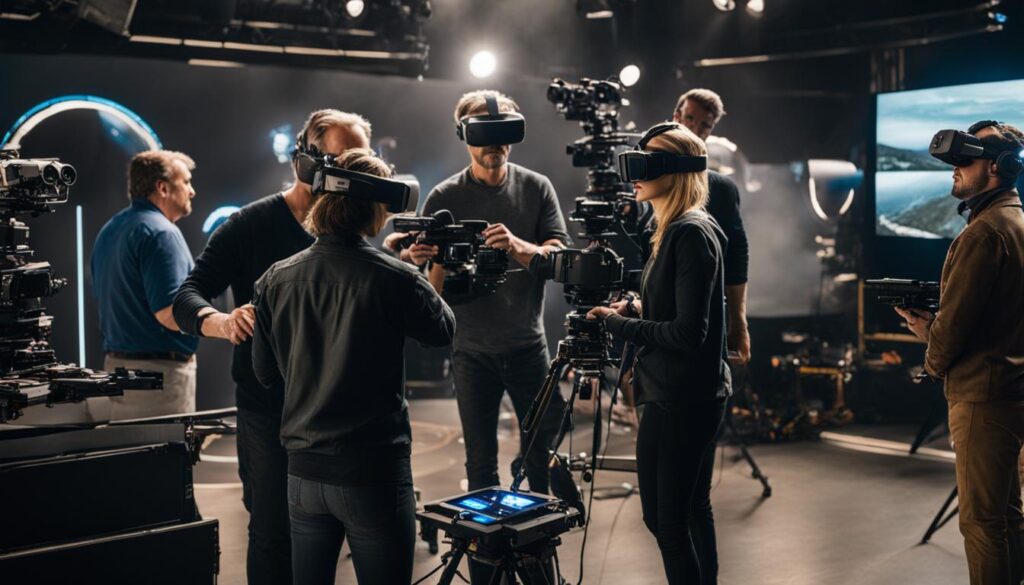
In looking ahead, one thing is clear to me: the VR future trends are not merely about improvements in technology but profound shifts in the philosophy behind cinematic creation. Every new innovation in VR filmmaking carves out wider spaces for creativity, engagement, and exchange, setting the stage for a VR cinema forecast that is as boundless as our collective imagination.
As a filmmaker, I stand at the ready, eager to continue exploring these burgeoning vistas of virtual reality. The journey thus far has been nothing short of revolutionary, and I eagerly anticipate the next chapters in this extraordinary voyage of discovery and innovation.
Conclusion: My Take on VR’s Role in Evolving Cinematic Experiences
Immersed in the wave of the VR Cinematic Evolution, my reflections on Virtual Reality circle back to a resounding recognition of its monumental impact on filmmaking. VR is not merely an advanced viewing platform; it’s a radical departure from traditional storytelling, inviting a deeper connection between stories and audiences. As a devoted participant in this media renaissance, my Personal Insights on VR attest to its singular capacity to merge the cinematic craft with the intricacies of human interaction, fostering a symbiosis of narrative and audience engagement unheard of in the annals of film.
The innovations being unveiled today are mere precursors to the Future of VR in Film, prophesizing a domain where every story is a universe unto itself, welcoming viewers to traverse and mold it with their very presence. VR, in its majestic stride, promises a cinematic landscape replete with unprecedented opportunities for creators and unparalleled experiences for viewers. It’s this undulating potential that paints the forthcoming journey of VR in the cosmos of film as not only thrilling but transformative in the deepest sense.
My pledge as a filmmaker is to continue exploring, innovating, and contributing to this future, understanding that the essence of cinema is evolving beyond the screen, into a realm of collaboration and visceral experience that VR uniquely sanctions. Standing at this juncture, I am emboldened by the possibilities and sincerely invite you to join me in witnessing and shaping the wonderful odyssey that is the Future of VR in Film.
FAQ
What is virtual reality (VR) in filmmaking?
Virtual Reality in filmmaking is a cutting-edge technology that allows filmmakers to create immersive experiences by placing viewers inside a movie, enabling a 360-degree view of a computer-generated world or a filmed scene. This technology transforms the way we engage with cinematic content, offering a new form of storytelling.
How has VR technology evolved in the filmmaking industry?
VR technology has evolved from a niche curiosity into a mainstream tool for filmmakers. It has progressed thanks to advancements in VR hardware and software, including more affordable and higher-quality VR cameras, more intuitive filmmaking tools, and enhanced graphical capabilities. These innovations are rapidly integrating VR into the cinematic workflow.
How is VR changing the pre-production process in filmmaking?
VR is revolutionizing pre-production by offering new ways to storyboard and plan films. Filmmakers are now able to visualize and explore scenes within a 360-degree space, perform virtual location scouting, and meticulously plan every angle and interaction viewers may have within the virtual environment before the actual filming begins.
What are some of the unique tools used in VR filmmaking?
In VR filmmaking, a variety of specialized tools are used, such as 360-degree cameras designed to capture the entirety of a scene, ambisonic microphones to record immersive audio, and VR headsets for real-time previews. These tools are essential for creating content that’s designed to encompass the viewer’s entire field of vision.
What are the challenges unique to shooting VR content?
Shooting VR content presents several challenges, including finding the optimal placement for the camera to ensure the crew is not visible, capturing consistent lighting across 360 degrees, and creating scenes that allow viewers to explore without disrupting the narrative. Innovative solutions involving remote control of cameras and considerations for spatial audio are vital to overcoming these challenges.
How does VR impact the post-production process?
VR significantly impacts post-production with the introduction of stitching and editing challenges unique to 360-degree footage. Editors must combine multiple camera angles seamlessly and consider viewer interaction while creating a coherent and engaging story. Specialized software is required to handle editing in a spherical space.
What role does VR play in film distribution and exhibition?
VR plays a transformative role in film distribution and exhibition by offering non-traditional platforms for showcasing films. As traditional cinemas aren’t equipped for VR, film festivals, VR-specific venues, and online platforms are becoming increasingly important for VR content dissemination. The rise of at-home VR viewing also changes the film distribution landscape.
Can you give examples of successful VR film projects?
Sure, there have been several VR film projects that have garnered attention and acclaim, demonstrating the medium’s potential. For instance, the documentary “Clouds Over Sidra,” which transports viewers to a Syrian refugee camp, and the narrative experience “Henry,” which won an Emmy for Outstanding Original Interactive Program, are both excellent examples of successful VR storytelling.
In what ways are filmmakers finding new opportunities through VR?
Filmmakers are finding new opportunities through VR by exploring uncharted narrative structures, inviting audiences into more engaging and participatory roles, and expanding their creative freedom. VR allows filmmakers to defy conventional filmmaking boundaries and create stories that are not just seen but experienced.
How is virtual reality changing audience engagement with movies?
Virtual reality is elevating audience engagement by offering an unprecedented level of immersion and interactivity. In a VR film, viewers can look around and sometimes interact with the environment, which heightens the emotional impact and sense of presence in the story, leading to a more personal and memorable experience.
What are the future trends for VR in movie making?
Future trends for VR in movie making include the development of more interactive narratives, advancements in visual fidelity, and enhanced accessibility for consumers and creators alike. We can expect VR to continue integrating into filmmakers’ toolkits, akin to how CGI has become a staple in modern cinema, revolutionizing the industry even further.
What is your personal take on VR’s role in the evolution of cinematic experiences?
My take is that VR represents a profound shift in cinematic storytelling. It adds an immersive dimension that challenges the traditional viewer experience by offering a participatory role within the narrative. I believe VR’s capability to connect audiences with stories on a deeper level is just starting to be tapped and will significantly shape the future of filmmaking.
